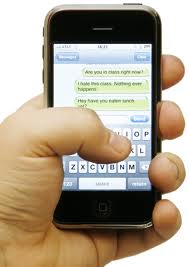 Americans spend an average of 2.7 hours a day on their cell phones. It is not uncommon for people to send dozens or even hundreds of text messages per day. This is common for both adults and teens. Recently a 14 year old ProActive PT patient was treated for texting thumb secondary to sending an average of over 300 texts per day. Mobile phone users are beginning to notice pain, tingling or numbness from excessive texting. Our dependency on texting to keep up with the Social Media has become a vital part of our life. “Giving your thumbs a rest” may not be a realistic solution in resolving symptoms associated with texting thumb for many of you.
Americans spend an average of 2.7 hours a day on their cell phones. It is not uncommon for people to send dozens or even hundreds of text messages per day. This is common for both adults and teens. Recently a 14 year old ProActive PT patient was treated for texting thumb secondary to sending an average of over 300 texts per day. Mobile phone users are beginning to notice pain, tingling or numbness from excessive texting. Our dependency on texting to keep up with the Social Media has become a vital part of our life. “Giving your thumbs a rest” may not be a realistic solution in resolving symptoms associated with texting thumb for many of you.
Texting thumb falls in the category of Repetitive Strain Injuries (RSI). Watch a person typing a text message on their smartphone, you will notice the bent thumb moving up and down in a repetitive motion. This motion can lead to tendonitis, which is an inflammation of a tendon. The inflammation of the tendon causes pain and numbness. Severe pain can lead to weakness in the hand resulting in an inability to hold objects such a coffee cup or even turn the key to start a car. Leading hand surgeons report that texting with your thumb can lead to trauma to the joints and ligaments in the hand. Biomechanically speaking experts report that 1 lb of pressure on the tip of the thumb multiplies to 4 lbs to the IP joint, 7 lbs to the MP joint and 14 lbs of pressure to the base of the thumb (CMC). The repetitive strain can develop into arthritis and carpal tunnel syndrome.
Suggestions on preventing texting thumb injuries:
- If you are a one handed texter, switch hands and use different fingers
- Use both thumbs/hands to decrease the stress on each one
- Take a break between sending multiple text messages
- Make a phone call instead
- Use your voice to type the text
- Stretch and flex your hands to keep the blood flowing
- Strengthen your hands and thumbs
*** Do NOT text while driving ***
If thumb/hand pain, tingling or numbness and swelling persist then see your MD and get a referral to see a Hand Therapist. A therapist can assist with decreasing inflammation, breaking down scar tissue, decreasing edema, decreasing pain, stretching and strengthening the thumb/hand, splinting and educating you on joint protection techniques. This will allow you to continue being independent and pain free with your ADLs (Activities of Daily Living).

